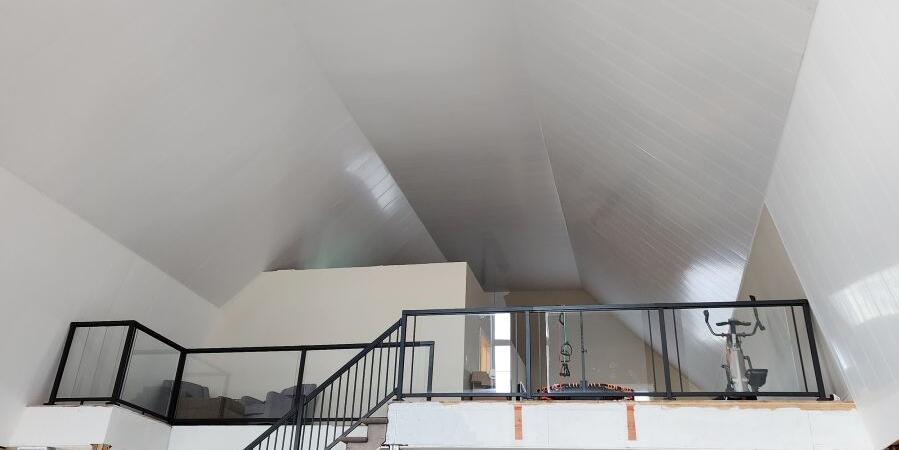Barndominimums or “barndos” are increasing in popularity as the red-hot real estate market and the cost of building materials like lumber are forcing buyers to find creative ways to own homes. But what are barndominiums and are they practical to live in? We cover the pros, cons, and costs of building or buying a barndo below.
What is a Barndominium?
Barndominium is a play on words combining the words “barn” and “condominium.” Coined by a real estate developer in the late 1980s, the term historically described properties that were an extension of a farm that combined a home for a farm owner to live and a boarding facility for their horses.
Today, a barndominium is any open concept steel building or barn that has been converted into a living space, including new builds and existing barns that have been retrofitted to function as a living space.
What are the Pros and Cons of Barndominiums?
Barndominiums offer a ton of benefits to potential homeowners and it’s easy to see why they’ve become a trendy property to own. Some of the upsides of a barndo include:
- Building Speed. While traditional homes take around seven months to build from start to finish, barndominiums can be built faster — simple barndominiums can be constructed in a matter of weeks, while more customized options take between three to six months. Shorter construction times mean lower construction and labor costs, so you can keep more money in your pocket.
- Durability. Barndos have metal or steel shells which make them resistant to mold, rot, termites, and the elements, which means they’ll likely last longer than a typical home made from wood.
- Open Floor Plan. Bardominiums are structurally sound and don’t need load-bearing walls, which means you’ll have an open floor plan to fully customize however you see fit.
- Fire Resistance. Steel has a melting point of 2,500 degrees Fahrenheit (or over 1,300 degrees Celsius), which means barndominiums are more fire-resistant than traditional homes.
- Environmentally Friendly. Many materials used to build barndominiums are environmentally friendly (unlike traditional homes which require lumber and drywall to build) and can help homeowners reduce their carbon footprint.
- Energy Efficiency. The metal roofing of a barndominium can help reduce energy consumption and lower cooling costs.
However, nothing is ever perfect and barndos are no exception. If you’re considering building or buying a barndominium, consider this list of downsides before you sign your name on a dotted line:
- Location Limitations. Building codes in your local town or city could prevent you from building a barndominium within its limits. To create the barndo of your dreams, you may have to live in a more rural area away from amenities where the codes aren’t as strict.
- Financing. Barndominiums aren’t classified as a manufactured home, which can make it difficult to be approved for a traditional mortgage loan.
- Corrosion. In the same way that traditional homes with wooden frames are prone to rotting, metal-based barndominiums are prone to corrosion over time, especially if you live in a tropical or humid climate.
- Noise. Since they’re made from metal or steel, barndominiums transfer sound more easily than a traditional home, especially from wind, rain, and hail.
- UV Exposure. Barndos often have large windows to let lots of light in, but this can contribute to fading your floors (whether it be hardwood or carpet) and your furniture. If you can, consider adding window film to your windows and doors for extra UV protection, but know it will come at an extra cost.
- Wiring Challenges. Metal walls can present wiring challenges, and any repairs will require hiring a professional welder and an electrician to get the job done.
- Reselling. Even though the real estate market is red-hot, barndominiums are harder to sell to the average home buyer because they’re often extremely customized and difficult to change.
Tremblay Barndominium Ceiling
- Location: Notre-Dame-des-Prairies, Quebec, Canada
- Application: Barn & Workshop
- Product(s): Trusscore Wall&CeilingBoard
How Much Does a Barndominium Cost?
If you’ve weighed the pros and cons and have decided owning a barndo is in your future, the last factor you’ll have to consider is price.
Like with building a traditional house, the cost of a barndominium depends on several factors, including its size, the amount of land that comes with it, interior customizations, and finishes. On average, homeowners can expect to pay anywhere between $70 to $140 per square foot, with the price increasing for higher finishes. In comparison, a new build, single family home can cost between $100 to $300 per square foot even if you opt for more affordable finishes.
Interior Wall & Ceiling Material for Barndominiums
If you’re building a custom barndo, you’ll have full control over what it will look like on the inside. When it’s time to choose an interior wall and ceiling solution, consider using Trusscore Wall&CeilingBoard.
Our panels come in lengths as long as 20 feet, meaning they can quickly and effectively cover any structure that’s oversized in nature. They’ve been used for years in both barns and homes, and will allow you to bring a similar level of the durability and water resistance that you have on the outside of your barndo into your home.
"Installing Trusscore was the best decision ever. I wouldn’t have wanted drywall on 33-foot ceiling !!!!!" - Hélène Tremblay Chute
Looking for an on-the-wall storage solution? Add Trusscore SlatWall to your order. The 8-foot long, interlocking panels seamlessly integrate with Trusscore Wall&CeilingBoard and can be installed as a track, section, half wall, or a full wall. When it’s time to accessorize, you also have a full range of options — Trusscore offers several SlatWall hardware options (including shelves, baskets, and hooks) that snap into place and is compatible with any standard 3” slatwall accessory from other manufacturers.
Still on the fence about barndominiums? Even if the price tag seems favorable, just remember: Though they’re trendy, barndominiums aren’t for everybody. If they don’t meet your unique needs as a homeowner, there’s nothing wrong with sticking with what you know and building or buying a traditional home.
Trouver un revendeur
Trusscore travaille avec des milliers de détaillants à travers l'Amérique du Nord pour vous offrir le meilleur service et le meilleur accès à nos produits.
Products for Barndominiums
Wall&CeilingBoard
Trusscore Wall&CeilingBoard est un panneau intérieur à emboîtement pour murs et plafonds en PVC qui est léger, nécessite peu d'entretien et surpasse les produits alternatifs tels que les cloisons sèches et le FRP.
En savoir plusSlatWall
Trusscore SlatWall est un système d'organisation mural très résistant, facile à installer et qui s'intègre parfaitement à Trusscore Wall&CeilingBoard.
En savoir plus

















